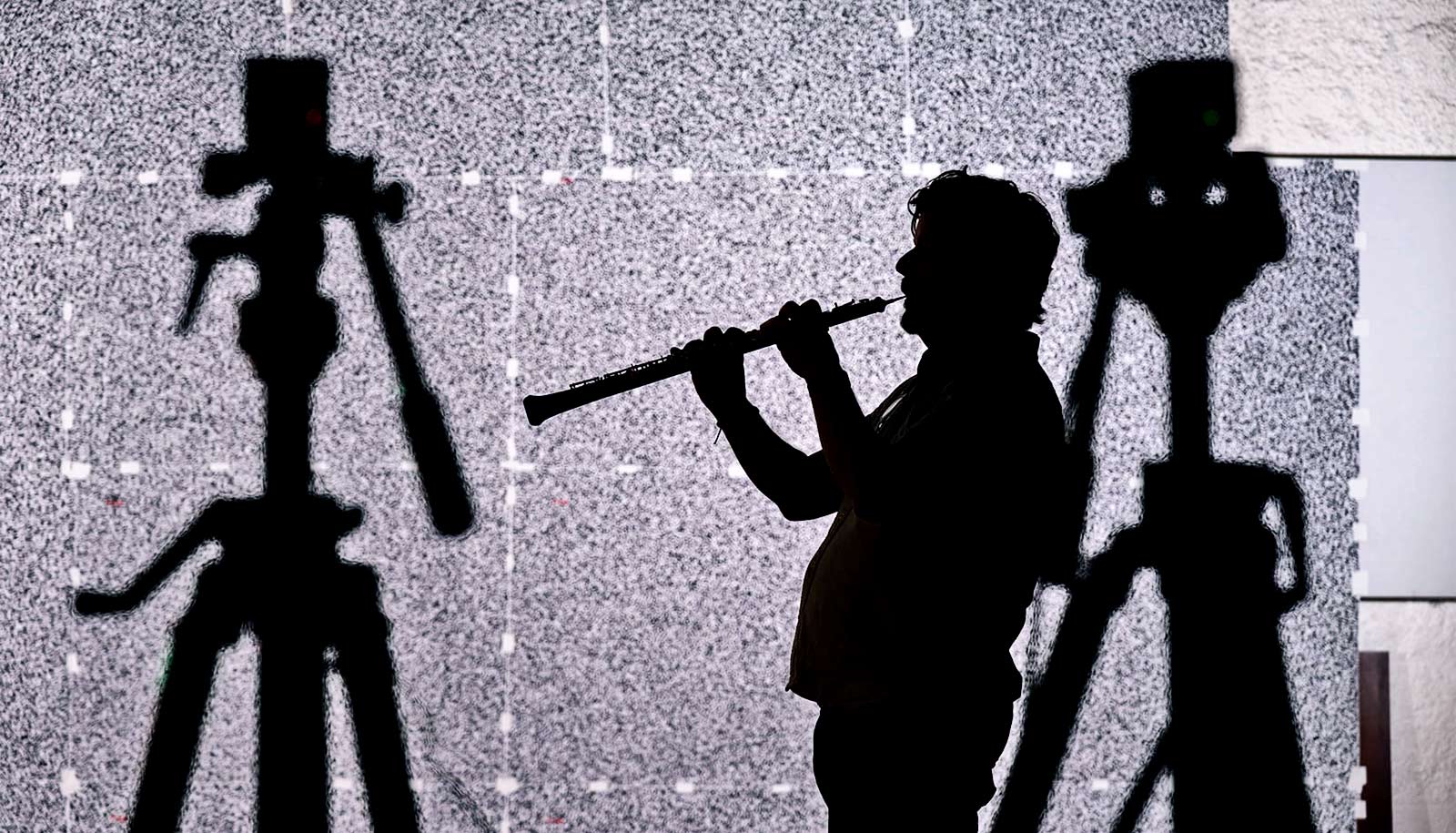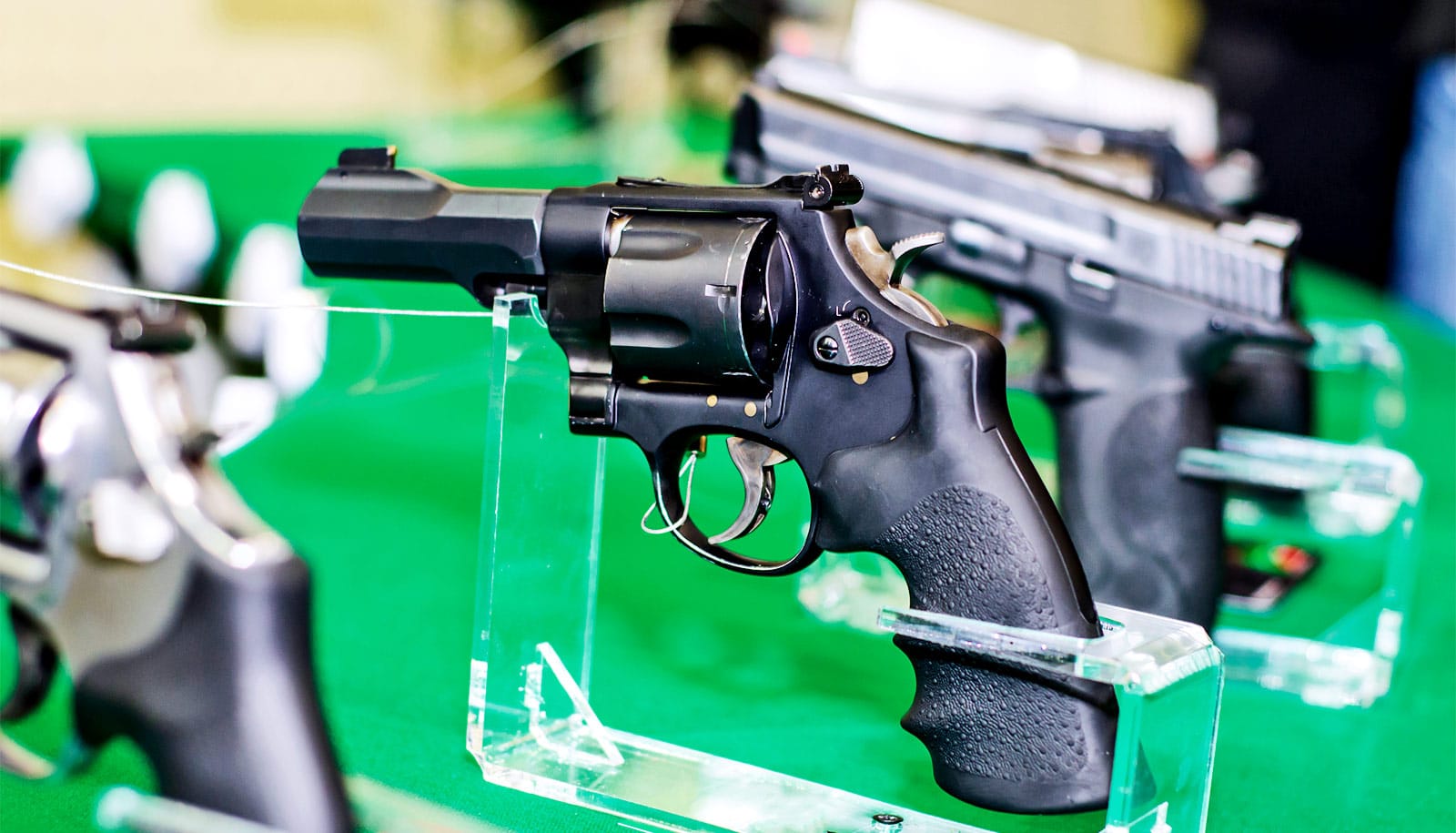
Backlighting required for background-oriented schlieren imaging experiments produced this silhouette of Jonathan Fischer, principal oboe with the Houston Symphony, during experiments at Rice’s Shepherd School of Music in late August. (Credit: Brandon Martin/Rice)
6 feet may not keep musicians safe during the pandemic
A new study looks at the droplets musicians exhale on stage to figure out how to keep performers and audiences safe during the COVID-19 pandemic.
Musicians may need more than social distancing to stay safe on stage during the COVID-19 pandemic, according to a new study of exhaled aerosols.
Researchers used a high-speed camera to track the movements of exhaled air released by singers and musicians who play wind instruments for Rice University’s Shepherd School of Music and for the Houston Symphony.
“ Social distancing is an important part of minimizing pandemic-related risks, but our study points to the importance of other factors as well,” says Ashok Veeraraghavan, a Rice imaging expert involved in the study.
“Our main message is that there is no single silver bullet. Performance venues are going to need a mix of several different risk mitigation strategies. Each of them will help a little, and the sum total of all of them will minimize risk to both the performers and the audience.”
With musical organizations around the world making plans for fall performances, the researchers opted to publish their data , analysis, and recommendations online, prior to scientific peer review.
“People are making decisions about how to return to the stage, and an important goal of this project was to provide guidance for them as quickly as possible,” says Robert Yekovich, dean of the Shepherd School of Music and co-principal investigator of the study. “Peer review may take a year or more, and we believe it is imperative to make others aware of what we found.”
Exhaled air from mouths and instruments
The COVID-19 pandemic brought traditional orchestra and opera performances to an abrupt halt in the spring. With tens of thousands of professional musicians sidelined, the overriding question was whether there was a way to modify orchestral and opera performances to continue during the pandemic.
In search for scientific answers, Yekovich and John Mangum, president and CEO of the Houston Symphony, partnered with Veeraraghavan, a professor of electrical and computer engineering in Rice’s Brown School of Engineering.
Using schlieren imaging, a decades-old technique for filming airflow, Veeraraghavan’s team filmed a female and male singer as well as performers playing the flute, oboe, clarinet, bassoon, horn, trombone, trumpet, and tuba. Three members of Veeraraghavan’s research group, postdoctoral researcher Vivek Boominathan and graduate students Ankit Raghuram and Sean Farrell, conducted the experiments in a large rehearsal hall at the Shepherd School in late August.
Though invisible to the naked eye, air is in constant motion. Using a combination of cameras, a specially printed high-resolution background, and computational algorithms allowed Veeraraghavan’s team to visualize the direction and flow of exhaled air coming from the musicians’ instruments and mouths.
Veeraraghavan says existing social distancing guidelines and recommendations largely stem from well-documented studies on relatively large droplets of exhaled fluid that fall to the ground within a few feet.
In contrast, the researchers designed the new experiments to capture information about exhaled aerosols, tiny microdroplets of fluid that may behave in a fundamentally different way from large droplets.
Aerosols can linger in the air for minutes or hours and are an important factor in the spread of airborne diseases. Mounting evidence suggests the coronavirus that causes COVID-19 can spread through aerosols.
“Our hypothesis going into the study was that microdroplet spray in front of the singer and instruments was the thing we needed to pay the most attention to,” Veeraraghavan says.
The experiments showed that much of the air exhaled by performers, even those playing instruments, tended to rise toward the ceiling and join air currents created by the room’s air-conditioning vents.
“Airflow disturbance was concentrated around subjects’ mouths and the holes in their instruments,” Veeraraghavan says. “Because exhaled air was warmer than the room air, we found most of it rose rather quickly, carrying the bulk of exhaled microdroplets into air currents that were primarily driven by ventilation.”
Masks for musicians during the pandemic
Based on their findings, Veeraraghavan says the authors recommend music venues ensure ventilation systems meet or exceed federal guidelines of six room air exchanges per hour. “More is clearly better in terms of risk mitigation,” he says.
The researchers also suggest venues examine the direction of air currents, especially above the performance stage, and consider ways to capture and filter air above the stage.
“Outflow vents above the performance stage will help, but there may be other ways to engineer solutions,” Veeraraghavan says. “Our study clearly shows that ventilation is important. The next step is to work with ventilation experts to use this knowledge in designs that make spaces safer.”
It remains vitally important to use social distancing to minimize the risk of spreading COVID-19 via large exhaled droplets, Veeraraghavan says. Music venues should require masks and apply standard social distancing guidelines of 6 feet between performers and audience members alike, he says.
Designing masks that allow performers to play their instruments but block some air that might otherwise escape from the sides of their mouths could offer creative solutions, he says.
“Going into this, it looked like safety was primarily going to be a matter of distance between performers on stage and between performers and audience,” says Mangum, a co-principal investigator of the study.
“The Rice experiments showed it’s more complex than that. Now we want all musical organizations and individual musicians to benefit from that understanding.”
Source: Rice University
The post 6 feet may not keep musicians safe during the pandemic appeared first on Futurity .
Share this article:
This article uses material from the Futurity article, and is licenced under a CC BY-SA 4.0 International License. Images, videos and audio are available under their respective licenses.
Related Articles:
6 feet may not keep musicians safe during the pandemic
Oct. 8, 2020 • futurityCOVID-19 fear is driving up gun sales
Dec. 17, 2020 • futurityLinks/images:
- https://www.futurity.org/social-distancing-covid-19-outbreaks-2378002-2/
- http://computationalimaging.rice.edu/research/tunesflow/
- https://www.futurity.org/music-education-virtual-learning-2424532-2/
- https://www.futurity.org/dna-sensor-nanofilter-1631052/
- https://www.futurity.org/face-masks-best-and-worst-materials-2399652/
- https://news.rice.edu/2020/10/05/musicians-may-need-more-than-social-distancing-to-stay-safe-on-stage/
- https://www.futurity.org/musicians-airflow-covid-19-2450462/
- https://www.futurity.org

